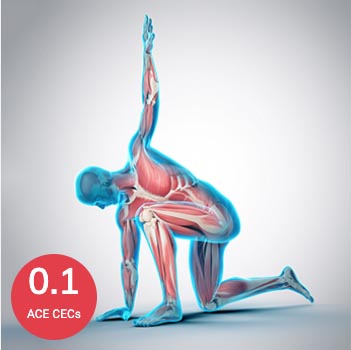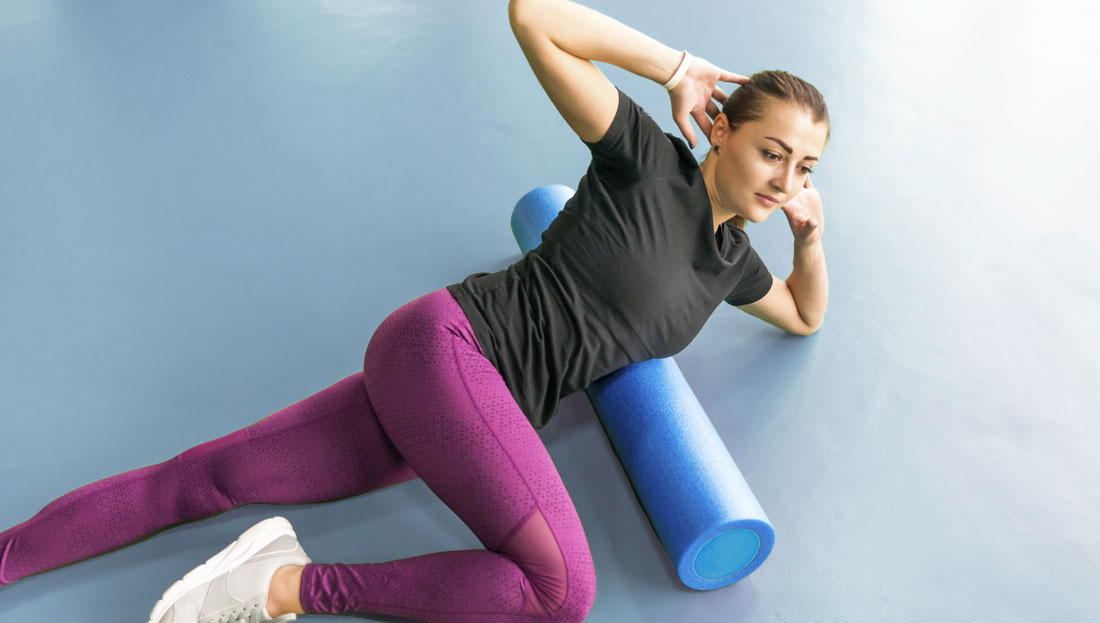
By Olivia Stovern, MS, Carley Henning, MS, John P. Porcari, PhD, Scott Doberstein, MS, Kari Emineth, MS, Blaine Arney, MS, and Carl Foster, PhD, with Daniel J. Green
Foam rollers, which are a mainstay in many fitness facilities, are often used as a form of self–myofascial release (SMR) during the warm-up of an exercise session or as a means of recovery between workouts. But what exactly is foam rolling meant to accomplish and how effective is it at achieving those objectives?
First, a primer on fascia and SMR: Understanding the concept behind SMR requires an understanding of the fascial system itself. Fascia is a densely woven, specialized system of connective tissue that covers and unites all of the body’s compartments. The result is a system in which each part is connected to the other parts through this web of tissue. Essentially, the purpose of the fascia is to surround and support the bodily structures, which provides stability as well as a cohesive direction for the line of pull of muscle groups. In a normal healthy state, fascia has a relaxed and wavy configuration. It has the ability to stretch and move without restriction. However, with physical trauma, scarring or inflammation, fascia may lose its pliability. SMR is a technique that applies pressure to tight, restricted areas of fascia and underlying muscle in an attempt to relieve tension and improve flexibility.
 Figure 1
Figure 1Fascia
The mechanisms and benefits of performing SMR on a foam roller are unclear, as research findings are often inconclusive or inconsistent. There are a few different potential reasons for this, including the fact that no standard protocol for foam rolling exists. Therefore, when trying to draw conclusions by looking at the results of multiple studies, it’s often a case of comparing apples to oranges.
In an effort to bring some clarity to the topic, ACE asked John P. Porcari, PhD, and his research team in the Department of Exercise and Sport Science at the University of Wisconsin–La Crosse to evaluate the training effects of foam rolling on lower-body flexibility and mobility and performance.
The Study
The research team recruited 34 volunteers to participate in the study (Table 1). Due to the physical demands of the testing and training procedures, participants were required to be at least recreationally active (i.e., exercise a minimum of three times per week for at least 30 minutes) and have no prior lower-leg injuries or cardiovascular or orthopedic contraindications to exercise. The participants were placed into either a foam-rolling group or control group.
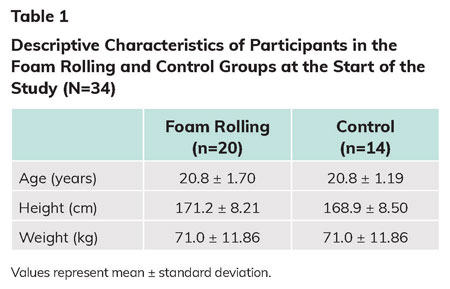
The study began with all participants attending an orientation session, during which they had a chance to practice all of the tests that were later administered as part of the study. In addition to height and weight, the following baseline data were collected during this session after a five-minute warm-up: ankle and knee range of motion (ROM), hamstring flexibility, vertical jump height and agility.
It is important to note that ROM and flexibility were measured using active assessments. For example, the participants were asked to dorsiflex the ankle as far as possible while seated upright on a table with legs straight and only the ankles off the edge of the table, at which point the measurement was taken. Dr. Porcari suggests that the difference between active and passive assessments (wherein a researcher pushes the ankle to achieve maximal dorsiflexion) may be another possible cause of some of the conflicting data found in the research on the topic of SMR.
To measure knee flexion, participants laid prone with their knees at the edge of the table and were instructed to flex their knees as much as possible. Hamstring flexibility was assessed using a sit-and-reach test. Finally, a vertical jump test to assess muscular power was conducted, as well as the T-test to assess agility (Figures 2 and 3).
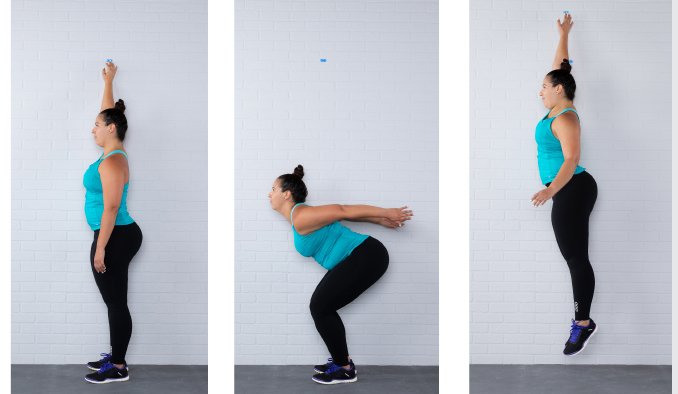 Figure 2
Figure 2Vertical jump
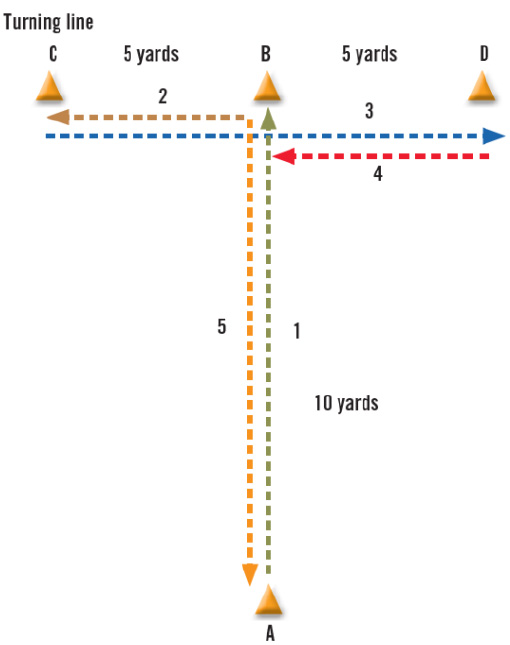 Figure 3
Figure 3T-test
The foam-rolling group participated in instructor-led sessions three days per week for six weeks. Each session consisted of foam rolling the lower back, buttocks, quadriceps, hamstrings, calves and iliotibial bands. Specific instructions were provided on how to foam roll each body part, including demonstrations by the researchers to ensure proper technique.
Each body part was foam rolled for 20 seconds and the entire sequence was repeated three times; each session lasted approximately 15 minutes.
Members of both groups were instructed not to change their dietary or exercise habits over the course of the six-week period. After the six weeks, all participants were reevaluated using the same assessment battery used at the beginning of the study. In addition, those in the foam rolling group were asked to complete a Perceived Performance Improvement Questionnaire.
The Results
All 34 participants completed the assessment protocol, and all members of the foam-rolling group completed 18 foam-rolling sessions during the six-week training period.
There was no change in body weight for either group. Data for all of the criterion measures are presented in Table 2. There were no significant changes in knee ROM, vertical jump or T-test time for either group. The foam-rolling group had a statistically significant increase in sit-and-reach distance from pre- to post-testing, which was also statistically significantly greater than the change in the control group. The results for ankle ROM were inconclusive, as both groups had statistically significant improvements in ankle ROM over the course of the study.

Answers to the Perceived Performance Improvement Questionnaire are presented in Table 3. It was found that the foam-rolling group felt more flexible and felt like they could jump higher at the conclusion of the study.

The Bottom Line
The purpose of this study was to determine the training effect of foam rolling on ankle and knee ROM, hamstrings flexibility, agility and vertical jump height. This research found a statistically significant improvement in lower back and hamstring flexibility (as measured by the sit-and-reach test) after six weeks of foam rolling. In addition, foam rolling did not negatively affect athletic performance, as measured by agility or vertical jump height.
“The fact that foam rolling does not do any harm in terms of performance is an important finding,” says Dr. Porcari. “This means that—in contrast to static stretching—foam rolling may be performed during the warm-up, potentially without any negative effect.”
In addition, the participants reported that, while foam rolling can sometimes be uncomfortable or even painful, they felt good afterward. And, as Table 3 shows, most participants felt more flexible and like they could jump higher at the end of the study, and about half felt they had improved in all elements tested. These findings regarding the perceived benefits may explain some of the allure of foam rolling, despite the lack of conclusively supportive evidence.

